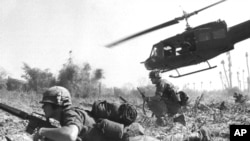The United States ended its involvement in the Vietnam War 35 years ago, and established diplomatic relations with Hanoi 15 years ago. But a recent visit to Vietnam by members of the U.S.-Vietnam Dialogue Group on Agent Orange and Dioxin saw the lingering effects of highly toxic chemicals used by U.S. forces to remove dense vegetation in a bid to flush out enemy combatants.
Agent Orange is the code name for one of the chemicals used by the U.S. Military during the Vietnam War. Agent Orange was given its name from the color of the large orange-striped barrels in which it was shipped. An estimated 45 million liters of Agent Orange were sprayed over parts of Vietnam, Laos and Cambodia.
Among the U.S. inter-faith delegation which recently returned from Vietnam was Rabbi Steve Gutow, the president and CEO of the Jewish Council for Public Affairs. "The damage from Agent Orange (and) dioxin was difficult to look at, to feel," he said. "And to know that we in some way contributed to this was very hard to take away. As a person who thinks America is as great a country as we have in the world, it just really upset me."
The U.S. Congress appropriated $3 million for fiscal 2007 and again for fiscal 2009 and 2010 for Agent Orange/dioxin work in Vietnam. Financial support is also coming from the Ford and other U.S. foundations, UN agencies and other governments. Some $30 million has been mobilized so far.
But Reverend Caroll Baltimore Sr., president of the progressive National Baptist Convention Inc., said more needs to done. "The damage is long term. And the hot spots are overwhelming even to the point in Da Nang for example where the land is still bare and baron, where no vegetation grows."
Sister Maureen Fielder also found the situation to be surprisingly bad after more than three decades. "The most poignant place was Da Nang, the Air Force base in Da Nang where we had stored and spilled so much of this poison," she said. "And what amazed me was that after 35 years you could still smell the stuff. It was so strong and so toxic."
The Vietnamese government and an independent expert firm, Hatfield Consulting of North Vancouver, Canada, conducted a series of independent assessments of dioxin residues in the environment around the Da Nang airport and in the blood and breast milk of current area residents. The results provided a clearer understanding of the problem in Da Nang, where the feasibility of bio-remediation efforts is being tested.
Rabbi Gutow did not need a study to realize the scope of the issue. "There was nothing harsher than Da Nang airport. We had to buy those shoes. We tried to make a joke of it where you buy these shoes you had to throw away. Because when you walked there you knew what we had left there under this concrete slab still had the capacity to hurt people and kill people. And we as a country have not stepped up to the plate and taken care of it."
Findings in of follow-up studies in 2009 indicated that the 2007 interim mitigation measures had succeeded in reducing dioxin exposure of people in the area. But the damage was evident to members of the inter-faith delegation as they saw Vietnamese children coping with physical hardships and deformities.
"This is one of the truly insidious effects of Agent Orange and dioxin. It gets passed on in the genetics of reproduction. And we have no idea how many generations might be affected by this," said Sister Maureen Fielder.
"In no individual case can anyone definitively connect Agent Orange with a specific disability," she said "None the less the connection is there certainly by correlation. Because the children that are disabled are overwhelmingly in the areas sprayed by Agent Orange and dioxin."
The idea for a citizen-to-citizen dialogue on Agent Orange was first explored in 2006 by the Ford
Foundation. The dialogue, which is not an implementing agency or a fundraising organization, was formally established in February 2007 as an initiative of prominent private citizens, scientists and policy-makers on both sides, working on issues that the two countries' governments have found.









